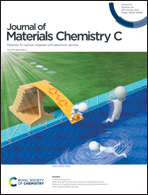Accurate prediction of pressure and temperature T1/2 variation in solid state spin crossover by ab initio methods: the [CoII(dpzca)2] case†
Abstract
The spin crossover (SCO) phenomenon is among the most complicated second-order transitions to be modelled from first principles. Some ad hoc strategies have been successful for modelling solution SCO, but this is rare for solid state SCO because of the added complexity coming from (a) interacting molecules and (b) packing effects. In this study, the solid state SCO transition of solvent-free crystalline [CoII(dpzca)2] is modelled through the calculation of the transition temperature (T1/2) under a range of different physical conditions. This candidate complex undergoes both thermal and pressure-activated SCO (quoted T1/2 values obtained at γHS = 0.5): from pressures of 1 to 2100 bar, the SCO is mostly abrupt (gradual:abrupt = 20 : 80; 173 K < T1/2 < 189 K); from 2500 bar a progressively increasing fraction of gradual-SCO replaces the last part of the abrupt transition (gradual:abrupt = 60 : 40; T1/2 = 202 K); at 4300 bar, the conversion to gradual SCO is almost complete (gradual:abrupt = 80 : 20; T1/2 = 235 K). In the first part of this study, a computational protocol was established that reproduces the experimental properties of crystalline high spin (HS) and low spin (LS) [CoII(dpzca)2] at the pressure of 1 bar. Then, this protocol was trialled at six different pressures, up to 4300 bar, and it accurately reproduced the available crystallographic data (HS [1 bar]; LS [1 bar and 4300 bar]) and the electronic structure (density of states; DOS). Extremely good predictions of T1/2 were obtained, with deviations from the observed values of less than 10 K, up to a pressure of 2100 bar, i.e. whilst crystalline [CoII(dpzca)2] undergoes mostly an abrupt SCO transition. Above 2500 bar, when the abrupt part of the SCO transition becomes increasingly gradual, the divergence between the experimental data and theoretical predictions increases. Considering the numerous degrees of freedom involved in ab initio SCO modelling, the results obtained for [CoII(dpzca)2] at pressures up to 2500 bar are very encouraging. The observed divergence for p > 2500 bar is likely due to a crystal transition or phase change of the HS [CoII(dpzca)2] unit cell, as the only available crystallographic data in this pressure range (LS [CoII(dpzca)2] at 4300 bar) are in excellent agreement with the computed ones.
![Graphical abstract: Accurate prediction of pressure and temperature T1/2 variation in solid state spin crossover by ab initio methods: the [CoII(dpzca)2] case](/en/Image/Get?imageInfo.ImageType=GA&imageInfo.ImageIdentifier.ManuscriptID=D1TC03467G&imageInfo.ImageIdentifier.Year=2021)


 Please wait while we load your content...
Please wait while we load your content...